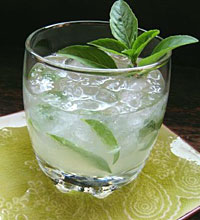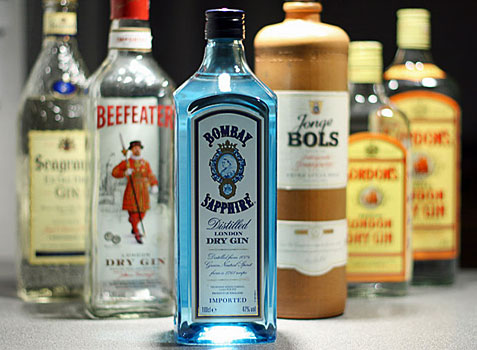It’s lost some commercial ground to vodka over the decades, but the revival of interest in classic cocktails has given gin a boost lately. In any case, this venerable liquor remains the standard clear alcohol among serious cocktail aficionados, who strongly prefer its more complex flavor and swear it’s the only true main ingredient in a martini.
 Gin is distilled from grain, usually wheat or rye, and starts out as a fairly plain spirit probably not so different from vodka. After that, “distilled gins” are then distilled a second time with various flavorings. The most prominent being juniper berries. That’s only for starters, as gin manufacturers use a pretty vast assortment of herbs and other botanicals ranging from licorice root to grapefruit peels to the perfumey bergamot we associate with Earl Grey tea. Some ultra-cheap brands are “compound gins.” These gins are not redistilled, but simply have tiny infusions added — they’re basically gin-flavored alcohol.
Gin is distilled from grain, usually wheat or rye, and starts out as a fairly plain spirit probably not so different from vodka. After that, “distilled gins” are then distilled a second time with various flavorings. The most prominent being juniper berries. That’s only for starters, as gin manufacturers use a pretty vast assortment of herbs and other botanicals ranging from licorice root to grapefruit peels to the perfumey bergamot we associate with Earl Grey tea. Some ultra-cheap brands are “compound gins.” These gins are not redistilled, but simply have tiny infusions added — they’re basically gin-flavored alcohol.
Most modern gins are “dry” and manufactured in England; these gins legally may not contain any added sugar and that aids in the liquor’s superb mixability. As far as we can tell, however, there isn’t much predictable difference between “London dry, “extra dry,” and other similar designations. “Plymouth” gins technically only have to come from the coastal town, but they tend to have a somewhat more complex, pungent, and slightly sweeter flavor profile. Largely produced in Holland and Belgium, genever is a less strong gin variant popular in central Europe. With plenty of added sugar, you can still find very sweet “old Tom” gin if you look hard. Speaking of sweet, you’ve likely had a slurp or two or of “sloe gin,” actually a liqueur made with gin or cheaper neutral spirits mixed with sloe berries. Most brands of gin are between 84 and 92 proof (42-46 percent alcohol), but a number of less upscale mass market brands are available at 80 proof or even less.
Like all types of booze, gin is available in a number of price levels, but there’s not really any such thing as a super premium gin. While you can easily spend $150.00 or much more on a bottle of small batch bourbon or single malt Scotch, if you find a bottle of regular size bottle of gin selling for more than $50.00, you’re probably paying mostly for ultra-fancy packaging. Some of the best and/or most popular premium gins include Tanqueray Ten, Plymouth (a brand as well as style of gin), and Bombay Sapphire. Just as good or better, in our opinion, are the mid-priced premiums, available in some states at discounters like Costco, Bev-Mo and Trader Joe’s. These include Tanqueray, Bombay Dry Gin (less heavy on the perfumey juniper berries than Sapphire), and Hendricks, an increasingly popular Scottish gin we like quite a bit. A bit cheaper, still quite good, and very rich in “Mad Men”-style classic street cred, is Beefeater.
At the dirt cheap level, a bottle of a slightly bastardized classic, Gordon’s Gin, may still give you a dollar or two in change from your ten spot and the double-size bottles are even more of a steal. It’s only 80 proof these days and not the same drink it was when it was named by James Bond creator Ian Fleming for his famous “Casino Royale” Vesper cocktail in the 1950s. Nevertheless, it’s a good enough gin that it works as well in a dry martini as it does mixed with tonic water.
Ironically, the drink famously quaffed by English aristocracy as well as more middle class tipplers was once, for all intents and purposes, the crack cocaine of alcoholic beverages. Gin was first developed by a Dutchman named Dr. Franciscus de la Boë, who marketed the drink as a medicinal diuretic. (We’re pretty sure it worked!) Then, the Dutch-born William of Orange ascended to the English throne as part of the “Glorious Revolution” of 1689. Apparently eager to encourage a beverage of his native land, he abolished taxation and licensing for the liquor. The result was a very cheap but often dangerous English version of the drink. Turpentine was a common flavoring agent and the poor were the likeliest victims of an array of serious health dangers from drinking the stuff, which they did quite a lot since it was so inexpensive. The problem was eventually rectified in England as the government reasserted it’s authority to regulate gin. However, problems reappeared in the 20th century United States with the occasionally blindness producing “bath tub gin” of the prohibition era. Draw your own political conclusions from the above.
Fortunately, now drinking the driest of gin martinis is legal, regulated and taxed. It’s also safe as long as you consume it sensibly and don’t choke on the olive.
Related Posts
You can follow us on Twitter and Facebook for content updates. Also, sign up for our email list for weekly updates and check us out on Google+ as well.
Posted in: Food & Drink, Lifestyle, Vices
Tags: bath tub gin, Beefeater, Bombay Dry Gin, Bombay Sapphire, booze, Casino Royale, compound gin, distilled gin, Dr. Franciscus de la Boe, gin, gin brands, gin cocktail, gin history, Glorious Revolution, Gordon's Gin, Hendrick's, liquor, London dry, mad men, mixology, old Tom gin, Plymouth, sloe gin, spirits, Tanqueray Ten, Turpentine, Vesper, William of Orange











